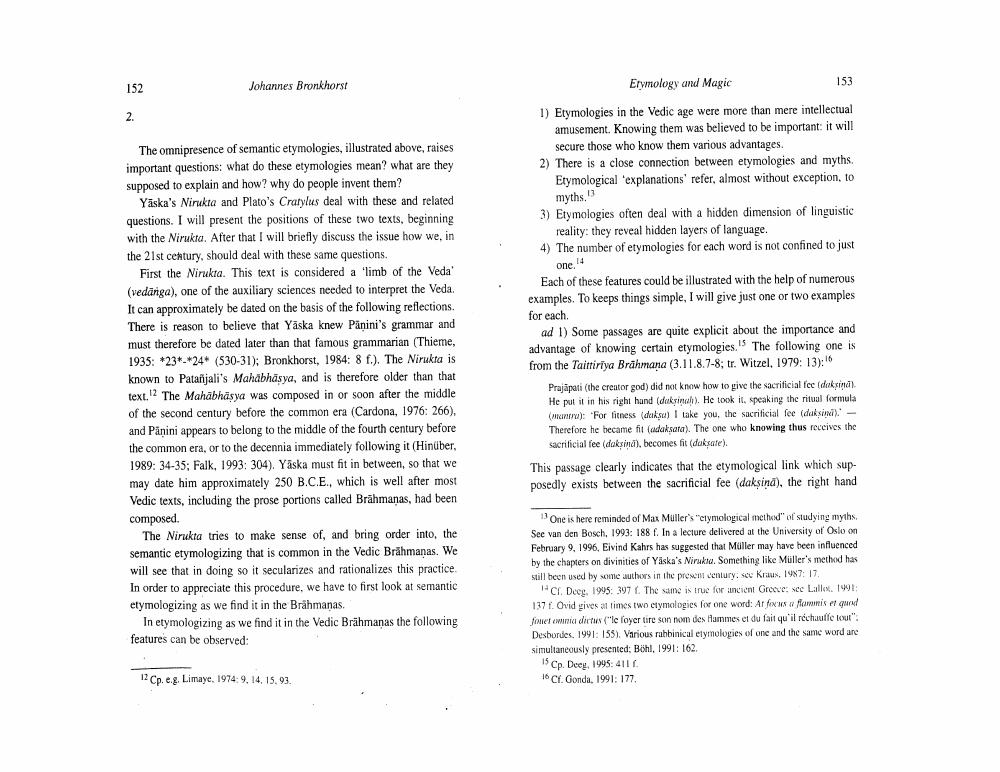Book Title: Etymology And Magic Yaskas Nirukta Flatos Cratylus And Riddle Of Semanticetymologies Author(s): Johannes Bronkhorst Publisher: Johannes Bronkhorst View full book textPage 4
________________ 152 2. Johannes Bronkhorst The omnipresence of semantic etymologies, illustrated above, raises important questions: what do these etymologies mean? what are they supposed to explain and how? why do people invent them? Yaska's Nirukta and Plato's Cratylus deal with these and related questions. I will present the positions of these two texts, beginning with the Nirukta. After that I will briefly discuss the issue how we, in the 21st century, should deal with these same questions. First the Nirukta. This text is considered a 'limb of the Veda' (vedänga), one of the auxiliary sciences needed to interpret the Veda. It can approximately be dated on the basis of the following reflections. There is reason to believe that Yäska knew Panini's grammar and must therefore be dated later than that famous grammarian (Thieme, 1935: *23*-*24 (530-31); Bronkhorst, 1984: 8 f.). The Nirukta is known to Patanjali's Mahabhāṣya, and is therefore older than that text.12 The Mahabhāṣya was composed in or soon after the middle of the second century before the common era (Cardona, 1976: 266), and Panini appears to belong to the middle of the fourth century before the common era, or to the decennia immediately following it (Hinüber, 1989: 34-35; Falk, 1993: 304). Yäska must fit in between, so that we may date him approximately 250 B.C.E., which is well after most Vedic texts, including the prose portions called Brahmanas, had been composed. The Nirukta tries to make sense of, and bring order into, the semantic etymologizing that is common in the Vedic Brahmanas. We will see that in doing so it secularizes and rationalizes this practice. In order to appreciate this procedure, we have to first look at semantic etymologizing as we find it in the Brähmanas. In etymologizing as we find it in the Vedic Brahmanas the following features can be observed: 12 Cp. e.g. Limaye, 1974: 9, 14, 15, 93. 153 Etymology and Magic 1) Etymologies in the Vedic age were more than mere intellectual amusement. Knowing them was believed to be important: it will secure those who know them various advantages. 2) There is a close connection between etymologies and myths. Etymological explanations' refer, almost without exception, to myths,13 3) Etymologies often deal with a hidden dimension of linguistic reality: they reveal hidden layers of language. 4) The number of etymologies for each word is not confined to just one. 14 Each of these features could be illustrated with the help of numerous examples. To keeps things simple, I will give just one or two examples for each. ad 1) Some passages are quite explicit about the importance and advantage of knowing certain etymologies. The following one is from the Taittiriya Brahmana (3.11.8.7-8; tr. Witzel, 1979: 13):16 Prajapati (the creator god) did not know how to give the sacrificial fee (dakṣina). He put it in his right hand (dakyinah). He took it, speaking the ritual formula (mantra): For fitness (daksu) I take you, the sacrificial fee (dakṣina). Therefore he became fit (adakṣata). The one who knowing thus receives the sacrificial fee (dakṣina), becomes fit (dakçate). This passage clearly indicates that the etymological link which supposedly exists between the sacrificial fee (dakṣind), the right hand 13 One is here reminded of Max Müller's "etymological method" of studying myths. See van den Bosch, 1993: 188 f. In a lecture delivered at the University of Oslo on February 9, 1996, Eivind Kahrs has suggested that Müller may have been influenced by the chapters on divinities of Yäska's Niruktu. Something like Müller's method has still been used by some authors in the present century; sec Kraus, 1987: 17. Cf. Deeg, 1995: 397 1. The same is true for ancient Greece: see Lalles. 1991; 137 f. Ovid gives at times two etymologies for one word: Ar focus a flammis et quod fouet omnia dictus ("le foyer tire son nom des flammes et du fait qu'il réchauffe tout". Desbordes, 1991: 155), Various rabbinical etymologies of one and the same word are simultaneously presented; Böhl, 1991: 162. 15 Cp. Deeg, 1995: 411 1. 16 Cf. Gonda, 1991: 177.Page Navigation
1 2 3 4 5 6 7 8 9 10 11 12 13 14 15 16 17 18 19 20 21 22 23 24 25 26 27 28 29
